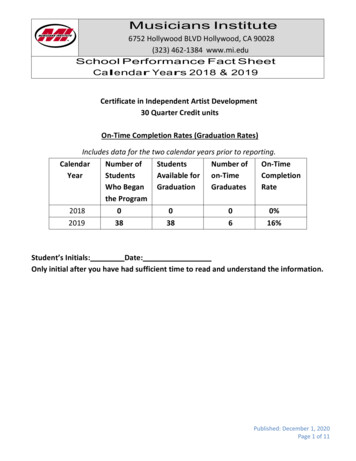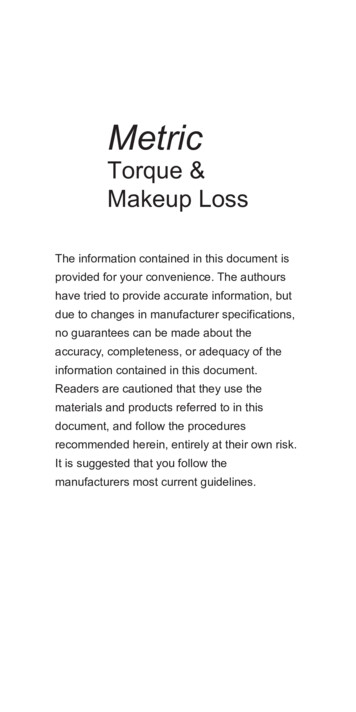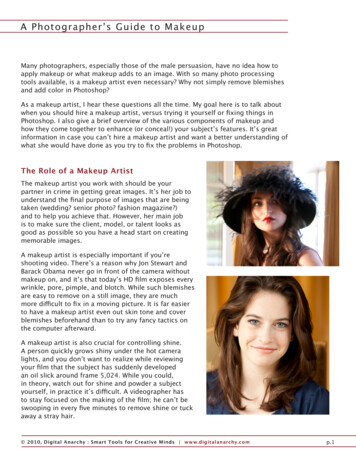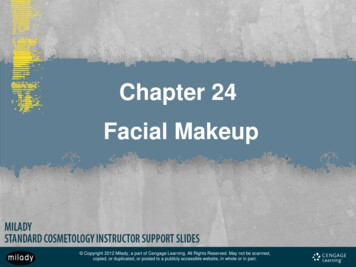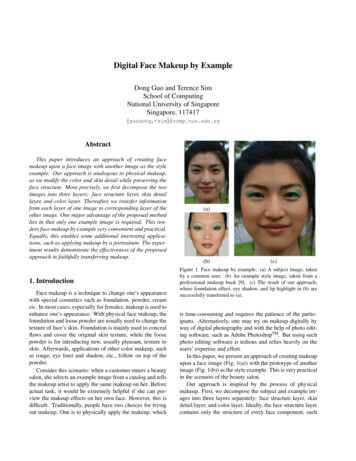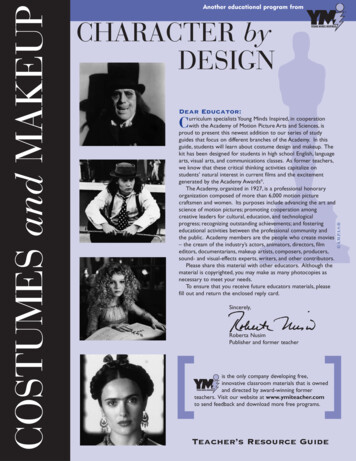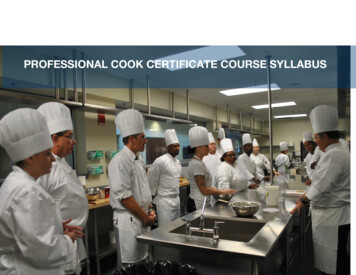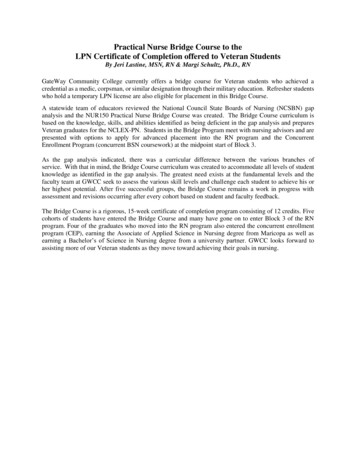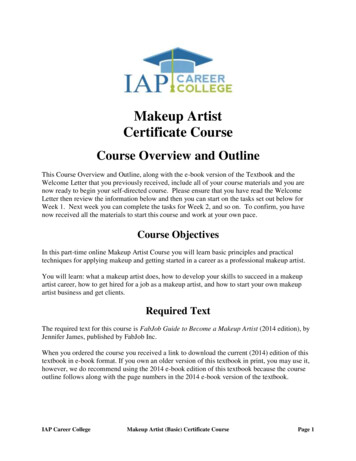
Transcription
Makeup ArtistCertificate CourseCourse Overview and OutlineThis Course Overview and Outline, along with the e-book version of the Textbook and theWelcome Letter that you previously received, include all of your course materials and you arenow ready to begin your self-directed course. Please ensure that you have read the WelcomeLetter then review the information below and then you can start on the tasks set out below forWeek 1. Next week you can complete the tasks for Week 2, and so on. To confirm, you havenow received all the materials to start this course and work at your own pace.Course ObjectivesIn this part-time online Makeup Artist Course you will learn basic principles and practicaltechniques for applying makeup and getting started in a career as a professional makeup artist.You will learn: what a makeup artist does, how to develop your skills to succeed in a makeupartist career, how to get hired for a job as a makeup artist, and how to start your own makeupartist business and get clients.Required TextThe required text for this course is FabJob Guide to Become a Makeup Artist (2014 edition), byJennifer James, published by FabJob Inc.When you ordered the course you received a link to download the current (2014) edition of thistextbook in e-book format. If you own an older version of this textbook in print, you may use it,however, we do recommend using the 2014 e-book edition of this textbook because the courseoutline follows along with the page numbers in the 2014 e-book version of the textbook.IAP Career CollegeMakeup Artist (Basic) Certificate CoursePage 1
Educational ApproachThis course is an online learning program with suggested readings and course assignments asdescribed in this course outline. This course is self-directed, which means that students maystudy and complete assignments at times that are most convenient for each student. This parttime course has a recommended completion date of 6 weeks from the start of the program,however, students may choose to complete the course in as little as 4 weeks or as long as 12weeks, depending on the student’s schedule.Learning AssistanceThe course has been created to allow you to complete it without any learning assistance. If yourequire assistance or have questions about the course content, you may submit questions byemail or talk with a faculty member by Skype (free online video or voice calls throughwww.skype.com) for up to one-half hour per week for six weeks.The faculty member for this course may be contacted by email at faculty@fabjob.com or byphone at 403-873-1018 (messages). Faculty members aim to return messages within 24 hours onweekdays and weekend assistance may also be available depending on each faculty member’sschedule. Skype calls may be scheduled at times that are mutually convenient for both thestudent and faculty member.Assignment Grading DistributionAssignment% of Total MarkFinal Exam100%Recommended Completion DateDecember 29 (6 weeks after course starts)As mentioned above, students may choose to complete the course in as little as 4 weeks or aslong as 12 weeks, depending on the student’s schedule. Assignments may be completedwhenever is convenient for you and submission is not required.If you choose a different course completion date, you can change your Final Exam date to suityour schedule. It is not necessary to get permission from the college to do so; your exam will bemarked when it is submitted.When you are ready to write your Final Exam, contact IAP Career College atiapcollege@fabjob.com for a link to the exam and an access code.IAP Career CollegeMakeup Artist (Basic) Certificate CoursePage 2
GradesYour final grade will be in percentage form. International Association of Professions CareerCollege has established the following guidelines for grade distribution. A grade of 60% or higheris required to earn a certificate.90 to 100%A – Honors80 to 89%A – Excellent70 to 79%B – Good60 to 69%C – Satisfactory50 to 59%D – Needs Improvement0 to 49%F – FailFinal ExamWorth 100% of Final MarkSuggested Date to Take By: December 29When you are ready to take your Final Exam, contact the college by email atiapcollege@fabjob.com for a link to your test and an access code.To assist you in doing well on your Final Exam, it is recommended that you study and answerthe weekly Review Questions and then review the Answers each week to ensure that you knowthe correct answers. You do not need to submit your answers to Review Questions to us. TheReview Questions are included solely to assist you with your learning and to prepare you for theFinal Exam.IAP Career CollegeMakeup Artist (Basic) Certificate CoursePage 3
International Association of Professions Career CollegeMakeup ArtistCourse # MKPB-1114Starting November 17, 2014Week 1This week you will begin learning about a career in makeup artistry and exploring methods todevelop skills necessary in this profession.Tasks Complete the week 1 readings from Chapters 1 and 3 as indicated belowAnswer the week 1 review questionsOPTIONAL: Schedule your first half hour session with your faculty memberReadingsCompletionTopicsNovember 24 (week 1) IntroductionReadingChapter 1pages 15 to 24Makeup in SocietyA Career in Makeup ArtistryBenefits of the JobGetting ReadyChapter 3pages 98 to 126Developing Your Skills Visual/Aesthetic Skills Communication Skills Working with People Other Important SkillsIAP Career CollegeMakeup Artist (Basic) Certificate CoursePage 4
Ways to Learn the Job Study Makeup on Your Own Find Makeup-Related Work Volunteer Your Services Find a Mentor Intern with a Cosmetics CompanyEducational Programs Alternatives to Formal Education Cosmetology and Beauty SchoolsReview QuestionsFor the Final Exam, make sure you have studied and know the correct answers to the followingReview Questions which test your understanding and recall of each week’s readings. You do notneed to submit your answers to the review questions. (Answers to Review Questions appearafter all the weekly questions.)Week 1 Review Questions1. According to a Personal Care Products Council survey, which of the following is true?a. More than 80 percent of those surveyed said that light makeup is a good idea for womenin the workplaceb. Approximately 50 percent of those surveyed said no makeup is a good idea for women inthe workplacec. More than 80 percent of those surveyed said that heavy makeup is a good idea for womenin the workplaced. Approximately 20 percent of those surveyed said heavy makeup should be worn bywomen in the workplace during important meetings2. Which of the following types of makeup application is used to cover skin problems, suchas scars or burns?a.b.c.d.Straight makeupCharacter makeupCorrective makeupStage makeup3. In terms of education, you must attain which of the following to start a career as amakeup artist?a. Obtain a state license to practice makeup applicationb. Pass a written exam issued by an approved professional associationIAP Career CollegeMakeup Artist (Basic) Certificate CoursePage 5
c. Achieve a degree from a cosmetology schoold. There is no specialized training, license, or certification to start out4. As a makeup artist, you will need to assess which of the following before you begin themakeup application?a.b.c.d.ColorLightingDesignAll of the above5. Which of the following is NOT one of the three major keys to interacting with others as amakeup artist?a.b.c.d.Be a friendly “people” personMake sure the client will comply with your styleBe confident in a calm and reassuring wayKeep your cool, even under time pressure6. Which of the following is false regarding before-and-after photos?a.b.c.d.They are suitable for the professional makeup artist industryThey are suitable for private client workYou may want to add them to your websiteYou may want to add them to your portfolio7. When you’re just starting out as a makeup artist, which of the following strategiesshould you use to find a mentor?a. Try connecting with someone whom you are assisting on a makeup gigb. Don’t offer to pay the mentor for her time and advice; this would be awkwardc. If you meet with her, avoid setting a time limit since you want all your questionsansweredd. Find out what her career path was, then copy itIAP Career CollegeMakeup Artist (Basic) Certificate CoursePage 6
Answers to Review Questions:Week 1 Answers1. (a) According to research, 82 percent of survey respondents said that light makeup is agood idea for women in the workplace, but 80 percent of those surveyed believe thatheavy makeup is a definite workplace mistake. While proper makeup application canhelp people make a positive impression on others, improper makeup application canresult in a negative impression that may never fade. [p. 17]2. (c) “Corrective makeup” is used to cover scars, burns, and other skin problems orphysical disfigurements. [p. 20]3. (d) You don’t need years of specialized training, or any particular licenses or certificationto start out. What you do need is a drive and determination to succeed, a start-up kit ofcosmetics, and an eye for making people look their best. This career is open to youstarting today, and you can call yourself a professional makeup artist as soon as youbeautify your first client. [p. 24]4. (d) As a makeup artist, you will need an eye for what works in terms of color, lightingand design, even before you begin the technique of application. Some people have anatural flair for visualizing makeup design and applying it well. [p. 99]5. (b) The makeup artist who is better liked will most often get a job. To be that person, anartist needs to be competent and friendly. Being pleasant to be around on top of beinggood at the job is a great way for makeup artists to build relationships and attractbusiness. [pp. 103-104]6. (a) Before-and-after photos, while suitable for private client work, are not appropriate forthe professional makeup artist industry. At that point, your portfolio should consist of tearsheets from magazines or professional-quality photographs of published or public work.However, if you plan to build a business working with private clients, make sure you takebefore-and-after photos of your work to add to your website and portfolio. [p. 114]7. (a) Some of the best resources for learning makeup artistry are other makeup artists. Youcan go one of two routes with a mentor: you can simply ask them questions about thework, or you can assist them when they work. Once you have someone who is willing tospeak with you, set up a date and a time, as well as a time limit, so they don’t feelbarraged with questions. One way to speed up the process is to offer to pay the makeupartist for their time and advice. [pp. 116-118]IAP Career CollegeMakeup Artist (Basic) Certificate CoursePage 7
International Association of Professions Career CollegeMakeup ArtistCourse # MKPB-1114Starting November 17, 2014Week 2This week you will begin to learn how about the steps of applying makeup and the tools you willneed in order to work as a makeup artist.Tasks Complete the week 2 readings from Chapter 2 as indicated belowAnswer the week 2 review questionsOPTIONAL: Schedule your next half hour session with your faculty memberReadingsCompletionTopicsReadingDecember 1 (week 2)How to Do the JobChapter 2pages 27 to 70Supplies and Tools Your Kit Your Makeup Your Tools Proper HygieneSteps of Applying Makeup Assess the Look Prepare the Face Foundation Eye Makeup Blush Eye Color Complete the Look AirbrushingIAP Career CollegeMakeup Artist (Basic) Certificate CoursePage 8
Review QuestionsFor the Final Exam, make sure you have studied and know the correct answers to the followingReview Questions which test your understanding and recall of each week’s readings. (Answers toReview Questions appear after all the weekly questions.)Week 2 Review Questions1. Regarding your “kit,” which of the following should you do?a. Buy all tools and supplies you can think of, so that you’ll be prepared for anythingb. Shop as you pick up jobs, and invest part of the money you earn into building up yourmakeup supplyc. Bring your kit to the salon or spa where you workd. Assemble one giant kit, rather than several smaller kits for different projects2. Which of the following terms means a makeup product does not cause medogenicComedogenic3. Which of the following foundations will give heavier coverage, but still feel verylightweight when worn?a.b.c.d.LiquidSouffléCreamPowder4. What tool do you mix colors of makeup on?a.b.c.d.SpatulaPalette knifeMixing paletteSharpener5. When it comes to moisturizer, which of the following applies?a.b.c.d.You should concentrate on the forehead and chin when applyingAn oil-based moisturizer is usually the best choiceA moisturizer should be comedogenicA moisturizer is a finishing touch after makeup has been removedIAP Career CollegeMakeup Artist (Basic) Certificate CoursePage 9
6. Which of the following ethnicities is most likely to have an oily facial AmericanLatin-American7. Which of the following types of skin is prone to more noticeable facial blemishes?a.b.c.d.Darker skinSkin with yellow undertonesPale skinBrown skin8. Which of the following face shapes benefits from lowlights under the cheekbones, andhighlights above them applied in vertical strokes?a.b.c.d.RoundOvalHeart-shapedLong9. When applying liquid foundation, which of the following should you generally NOT do?a.b.c.d.Begin at the hairlineBe gentle around the eyesWork from top to bottomAlways apply foundation to the neck10. When it comes to highlighting and contouring, which of the following is false?a.b.c.d.Lighter colors draw out aspects of the faceThis is a key technique in theater makeupDarker shades make aspects of the face recedeThis technique helps the face to appear three-dimensionalIAP Career CollegeMakeup Artist (Basic) Certificate CoursePage 10
Answers to Review Questions:Week 2 Answers1. (b) A good way to build your kit is to shop as you pick up jobs. That way you can investpart of the money that you will earn through that job into building your supply ofmakeup. If you work at a salon, spa, or for a cosmetics company, all these items will besupplied for you. Also, to stay organized, you might choose to have several makeup kitsto accommodate your different projects. For example, you could devote one kit to liveevents, one to stage work, and another to special effects. [pp. 28-29]2. (c) Some cosmetics are hypo-allergenic (non-allergy-causing) while others are noncomedogenic (non-acne-causing). [p. 34]3. (b) A soufflé foundation gives a heavier coverage, but still feels very lightweight whenworn. For general use, foundation comes in several types: liquid, soufflé, cream, orpowder. [p. 36]4. (c) A mixing palette is a small flat piece of metal that you can use to mix different colorsof makeup on. The spatula (or “palette knife”) is used to mix the colors on the palette.These tools come in handy when you don’t have an exact foundation match and you needto combine two or more colors to match a client’s complexion. [p. 41]5. (d) A good moisturizer is a finishing touch to use after the makeup has been removed, oreven before on especially dry skin. Choose a light, non-comedogenic one, and smooth itgently over your client’s face, concentrating on the cheeks and the eye area. An oil-freemoisturizer is usually the best bet if a moisturizer is needed. [p. 43]6. (c) African-American women are most likely to have a facial complexion that is moreoily than dry. Try to find foundations and powders that control oil, but don’t contribute toan ashy look. [p. 49]7. (c) Women with less pigment in the skin and a pale or “porcelain” look are more prone tonoticeable facial blemishes, as there is more of a contrast between the blemish and theirskin. [p. 49]8. (a) Round faces are just about as wide as they are long. They benefit from lowlightsunder the cheekbones, and highlights above them applied in more vertical than horizontalstrokes. [pp. 50-51]9. (d) It is generally not necessary to apply foundation to the client’s neck unless there issome reason to do so, such as a blemish or razor burn. With liquid foundation, beginapplying at the hairline, and work downwards, from top to bottom, moving from thecenter outward. Be gentle around the eyes, and avoid the lips. [p. 57]IAP Career CollegeMakeup Artist (Basic) Certificate CoursePage 11
10. (b) For print and television makeup, highlighting and contouring is a key technique.Since these are two-dimensional mediums, the job of the makeup artist is to make theface appear three-dimensional or rounded. Applying highlights and contours to the skin isthe process of using lighter colors to draw out certain aspects of the face and darkercolors to minimize them. [p. 58]IAP Career CollegeMakeup Artist (Basic) Certificate CoursePage 12
International Association of Professions Career CollegeMakeup ArtistCourse # MKPB-1114Starting November 17, 2014Week 3This week you will continue to learn about how to do consultations for individuals andcorporations. Communication, etiquette and developing relationships with strategic partners willalso be covered.Tasks Complete the week 3 readings from Chapters 2 and 4 as indicated belowAnswer the week 3 review questionsOPTIONAL: Schedule your next half hour session with your faculty memberReadingsCompletionTopicsReadingDecember 8 (week 3)How to Do the Job (cont.)Chapter 2pages 71 to 97Specialty Makeup Makeup for TV, Film and Video Makeup for Fashion and Live Shows Makeup for Print Photography Makeup for Stage and Shows Corrective Makeup Makeup for MenSpecial Effects (SFX) SFX Supplies How to Achieve SFX LooksGetting HiredChapter 4pages 127 to 146Types of Employers Salons and Spas Retails Stores or BoutiquesIAP Career CollegeMakeup Artist (Basic) Certificate CoursePage 13
Cosmetics CompaniesPortrait PhotographyFinding Job Openings Advertised Positions Unadvertised PositionsJob Hunting Materials Your Resume Your Cover Letter Your Portfolio Letters of RecommendationReview QuestionsFor the Final Exam, make sure you have studied and know the correct answers to the followingReview Questions which test your understanding and recall of each week’s readings. (Answers toReview Questions appear after all the weekly questions.)Week 3 Review Questions1. For film, men usually require .a.b.c.d.Hardly any makeupThe same amount of makeup as womenGenerally a little more makeup than womenMore highlighting and contouring than women2. When it comes to different types of makeup application, which of the following is true?a.b.c.d.Photographic makeup should be less bright than street makeupStreet makeup should be more dramatic than photographic makeupStreet makeup should be less bright than photographic makeupPhotographic makeup should be more dramatic than stage makeup3. For makeup application in print photography, which of the following should you do?a.b.c.d.Use bluish makeup tones if the photos are taken outdoorsUse softer colors in the studioUse more vibrant colors outdoorsUse cool or peach makeup tones in the studioIAP Career CollegeMakeup Artist (Basic) Certificate CoursePage 14
4. Which of the following types of special effects makeup pulls the skin tight, sets hard, andcan be removed by peeling off?a.b.c.d.Rigid collodionLiquid latexDerma waxSpirit gum5. Which of the following makeup artist jobs typically keeps you in one place and offers asteady income?a.b.c.d.SalonsCosmetics companiesSpasRetail stores6. Which of the following venues for makeup artist jobs does NOT usually advertise?a.b.c.d.FilmPortrait photographySalonSpa7. When it comes to your portfolio, which of the following should you do?a. Make sure before-and-after photos are taken in the same light, with the same clothes andhair, so that viewers can make a direct comparisonb. Fill your portfolio with as many examples as you can, even “average” ones—you neverknow who may find them appealingc. Refrain from having different portfolios for different types of workd. Keep a backup copy of your portfolio, in case of theft, loss, or other mishapsIAP Career CollegeMakeup Artist (Basic) Certificate CoursePage 15
Answers to Review Questions:Week 3 Answers1. (a) For film, men usually require hardly any makeup. Film will reveal much more clearlythan television if a man has too much makeup on, so use a light hand and check how yourwork looks on camera before you decide on a look. [p. 73]2. (c) A general rule of thumb is that photographic makeup should be brighter than streetmakeup and less dramatic than stage makeup. [p. 81]3. (d) If the photos are to be taken in the studio, you’ll want to aim for cool colors or peachtones to counter the yellowish effect of tungsten studio lights. Photographs that are takenoutdoors in natural light require softer colors of makeup, whereas strong studio lightingrequires darker, more vibrant colors. If the photos are to be taken outdoors, you’ll want touse rosy or peach tones to counteract the bluish effect of natural daylight. [pp. 80-81]4. (a) Rigid collodion is a liquid that is brushed onto the skin to create realistic-lookingscars and wrinkles. When it dries, it pulls the skin tight and sets hard. It can be removedby peeling it off. Avoid using it around the eyes. [p. 89]5. (b) If you want a job that keeps you in one place and offers a steady income, working in adepartment store selling a makeup line is a great option. There are two ways you canwork applying makeup for a cosmetics company: you can work as a “resident artist” at asingle counter or retail location, or you can become a part of the company’s promotionalteam. [p. 131]6. (a) While you are not likely to find film or TV work advertised, salon, spa, cosmeticcounter and portrait photography work is frequently advertised in print and online. [p.134]7. (d) Your portfolio is a very important possession. If you lose it, you have no proof thatyou can do beautiful or amazing work. Therefore, safeguard your portfolio by keeping abackup copy. [p. 144]IAP Career CollegeMakeup Artist (Basic) Certificate CoursePage 16
International Association of Professions Career CollegeMakeup ArtistCourse # MKPB-1114Starting November 17, 2014Week 4This week you will to continue to learn about getting hired as a makeup artist. You will alsolook at starting your own business.Tasks Complete the week 4 readings from Chapters 4 and 5 as indicated belowAnswer the week 4 review questionsOPTIONAL: Schedule your next half hour session with your faculty memberReadingsCompletionTopicsDecember 15 (week 4) Getting Hired (cont.)ReadingChapter 4pages 146 to 157Interviews How to Prepare What to Wear How to Make a Great Impression Interview Questions Discussing Salary Following UpSuccess on the JobStarting Your Own BusinessChapter 5pages 158 to 184Getting Started Creating a Business Plan Start-up Funding Choosing a Name Legal StructureIAP Career CollegeMakeup Artist (Basic) Certificate CoursePage 17
InsuranceTaxesSetting up Your Business Choosing a Location Equipment and Supplies Employees and Contractors Keeping Track of Your FinancesReview QuestionsFor the Final Exam, make sure you have studied and know the correct answers to the followingReview Questions which test your understanding and recall of each week’s readings. (Answers toReview Questions appear after all the weekly questions.)Week 4 Review Questions1. Your “set bag” should adhere to which of the following?a.b.c.d.Contain smaller containers of your essential makeup productsHave just the essentials; no other additional items are requiredIt isn’t needed if you work on locationBe something you can tuck in your pocket2. Regarding makeup for TV, which of the following is true?a.b.c.d.Heavy application of pancake makeup is usedTelevision studios are typically warm which can result in makeup meltingConsumer brands like MAC will work on televisionBoth a. and b.3. What is/are the most important part(s) of your makeup kit?a.b.c.d.Your cosmeticsA sturdy canvas or leather caseYour toolsThat your kit is organized well4. What is the general shelf life of liquid cosmetics?a.b.c.d.4 to 6 months6 to 12 months1 to 3 months1 yearIAP Career CollegeMakeup Artist (Basic) Certificate CoursePage 18
5. Which of the following are skin undertones?a.b.c.d.Black and whiteBlue and yellowWhite and orangeRed and green6. When you are dressing for an interview, which color is always appropriate andfashionable for a makeup artist?a.b.c.d.BlueBlackWhiteRed7. In your makeup artist business plan, which of the following will you need to do?a.b.c.d.Indicate that you will be operating a service businessAvoid stating a specific makeup specialty, such as makeoversRefrain from including information on makeup for wedding or special eventsAll of the above8. When working out of a salon or spa, which of the following is false?a.b.c.d.You can get walk-by clientsYou may share clients with other image service providersIt is more risky than opening your own storeIt is a good way to build clienteleIAP Career CollegeMakeup Artist (Basic) Certificate CoursePage 19
Answers to Review Questions:Week 4 Answers1. (a) Your set bag should contain smaller containers of the most essential products in yourmain makeup kit. You will add items specific to the particular talent, such as the lipstick,gloss, powder, etc., to take to the set with you for quick touch-ups between shots. [p. 32]2. (c) Consumer brands like MAC or even Bobbi Brown work on television if there’s noneed for special effects. The old days of TV and film when thick makeup or pancakemakeup was applied with a heavy hand are gone. In addition, television studios arenormally cold, so even though the performer is under lights, the temperature of the roomkeeps the makeup from melting. [p. 35]3. (c) Your tools—brushes, sponges, and other implements—are the most important part ofyour makeup kit. A professional makeup artist will invest in a good set of tools becausehe or she knows that they are just that—an investment. If you are self-employed, as manymakeup artists are, you will be able to deduct all or part of the cost of your equipmentfrom your income taxes. [p. 40]4. (b) Liquid cosmetics should be replaced at least every 6 to 12 months. If any of yourcosmetics change in color, smell or consistency, whether they have reached theirsupposed life span or not, get rid of them. If you are working steadily, you will probablygo through your cosmetics quickly, but you should review the contents of your entire kitonce a month to be sure everything is still fresh. [p. 45]5. (b) People of all skin colors have either warm (yellowish) or cool (bluish) undertones.The foundation color you select should match the natural color of the skin. [p. 47]6. (b) Black is always appropriate and fashionable, and is a uniform-look that emphasizesthat you are a professional. Industry rumor has it that black is “the” color to wear to acosmetics company interview. You want to look trendy, but professional. [p. 148]7. (a) You’ll need to state in this section that, as a makeup artist, you’ll be operating aservice business. Don’t be afraid to get specific about the types of services you’ll beproviding. If you’re going to specialize in makeovers, for example, state that in yourdescription. If you’re going to focus on makeup for weddings and other events, include alittle information about what those areas involve, and don’t hesitate to point out why yourservices are important. [p. 160]8. (c) Working out of a salon or spa is less risky than opening your own storefront right offthe top, and can be a good way to build a clientele if you would like to open your ownmakeup service shop one day. Other benefits include getting walk-by clients or at leastthe notice of passers-by, and client-sharing with other image service providers. [pp. 176177]IAP Career CollegeMakeup Artist (Basic) Certificate CoursePage 20
International Association of Professions Career CollegeMakeup ArtistCourse # MKPB-1114Starting November 17, 2014Week 5This week you will learn about how to market your own makeup artist business. You will alsostart looking at how to begin work as a freelance makeup artist.Tasks Complete the week 5 readings from Chapters 5 and 6 as indicated belowAnswer the week 5 review questionsOPTIONAL: Schedule your next half hour session with your faculty memberReadingsCompletionTopicsDecember 22 (week 5) Starting Your Business (cont.)ReadingChapter 5pages 184 to 213Marketing Your Business Choose Your Target Market Promotional Materials Your Website Strategic Partners Networking Advertising Publicity and PromotionsWorking with Clients The Initial Consultation Makeup for Special Occasions Doing a Makeover Consultation Setting Your Fees Arranging PaymentIAP Career CollegeMakeup Artist (Basic) Certificate CoursePage 21
Freelancing as a Makeup ArtistChapter 6pages 214 to 233Getting Ready Testing or Test Shoots Time-For-Print (TFP) Assisting Other Makeup ArtistsPromotional Materials A Professional Portfolio “Comp” Cards A Demo Reel The Internet and Talent DirectoriesReview QuestionsFor the Final Exam, make sure you have studied and know the correct answers to the followingReview Questions which test your understanding and recall of each week’s readings. (Answers toReview Questions appear after all the weekly questions.)Week 5 Review Questions1. When you are first starting out as a makeup artist, which of the following target marketsshould you choose?a.b.c.d.Anyone who is willing to payTeensBridesDevelop your client base around your talents and interests2. Regarding model release forms, which of the following is true?a.b.c.d.They are required for both print and web photosThey are only required for photos displayed in printThey are only required for photos displayed on the webMany peo
natural flair for visualizing makeup design and applying it well. [p. 99] 5. (b) The makeup artist who is better liked will most often get a job. To be that person, an artist needs to be competent and friendly. Being pleasant to be around on top of being good at the job is a great way for makeup
